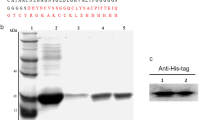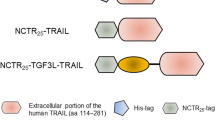Abstract
Tuftsin (TF) is an immunomodulator tetrapeptide (Thr-Lys-Pro-Arg) that binds to the receptor neuropilin-1 (Nrp1) on the surface of cells. Many reports have described anti-tumor activity of tuftsin to relate with nonspecific activation of the host immune system. Lidamycin (LDM) that displays extremely potent cytotoxicity to cancer cells is composed of an apoprotein (LDP) and an enediyne chromophore (AE). In addition, Ec is an EGFR-targeting oligopeptide. In the present study, LDP was used as protein scaffold and the specific carrier for the highly potent AE. Genetically engineered fusion proteins LDP-TF and Ec-LDP-TF were prepared; then, the enediyne-energized fusion protein Ec-LDM-TF was generated by integration of AE into Ec-LDP-TF. The tuftsin-based fusion proteins LDP-TF and Ec-LDP-TF significantly enhanced the phagocytotic activity of macrophages as compared with LDP (P < 0.05). Ec-LDP-TF effectively bound to tumor cells and macrophages; furthermore, it markedly suppressed the growth of human epidermoid carcinoma A431 xenograft in athymic mice by 84.2 % (P < 0.05) with up-regulated expression of TNF-α and IFN-γ. Ec-LDM-TF further augmented the therapeutic efficacy, inhibiting the growth of A431 xenograft by 90.9 % (P < 0.05); notably, the Ec-LDM-TF caused marked down-regulation of CD47 in A431 cells. Moreover, the best therapeutic effect was recorded in the group of animals treated with the combination of Ec-LDP-TF with Ec-LDM-TF. The results suggest that tuftsin-based, enediyne-energized, and EGFR-targeting fusion proteins exert highly antitumor efficacy with CD47 modulation. Tuftsin-based fusion proteins are potentially useful for treatment of EGFR- and CD47-overexpressing cancers.






Similar content being viewed by others
Abbreviations
- AE:
-
Active enediyne from lidamycin
- BSA:
-
Bovine serum albumin
- CSCs:
-
Cancer stem cells
- DSB:
-
DNA double-strand breaks
- Ec:
-
The C-loop of epidermal growth factor (22 amino acids of EGF COOH terminal)
- Ec-LDM-TF:
-
The enediyne-energized fusion protein composed of Ec, LDP, TF and AE
- Ec-LDP-TF:
-
The fusion protein composed of Ec, LDP and TF
- EGF:
-
Epidermal growth factor
- EGFR:
-
Epidermal growth factor receptor
- ELISA:
-
Enzyme-linked immunosorbent assay
- FACS:
-
Fluorescence-activated cell sorting
- FITC:
-
Fluorescein isothiocyanate
- HER2:
-
Human epidermal growth factor receptor-2
- HPLC:
-
High-performance liquid chromatography
- HRP:
-
Horseradish peroxidase
- IFN:
-
Interferon
- IgG:
-
Immunoglobulin
- LDM:
-
Lidamycin (composed of LDP and AE)
- LDM-TF:
-
The enediyne-energized fusion protein composed of LDP, TF and AE
- LDP:
-
Lidamycin apoprotein (110 amino acids)
- LDP-TF:
-
The fusion protein composed of LDP and TF
- Nrp1:
-
Receptor neuropilin-1
- TF:
-
Tuftsin (4 amino acids)
- TGF-β:
-
Transforming growth factor beta
- TGI:
-
Tumor growth inhibition
- TNF:
-
Tumor necrosis factor
References
Fridkin M, Najjar VA (1989) Tuftsin: its chemistry, biology, and clinical potential. Crit Rev Biochem Mol Biol 24:1–40
Nishioka K (1979) Anti-tumour effect of the physiological tetrapeptide, tuftsin. Br J Cancer 39:342–345
Jain S, Amiji M (2012) Tuftsin-modified alginate nanoparticles as a noncondensing macrophage-targeted DNA delivery system. Biomacromolecules 13:1074–1085
Nissen JC, Selwood DL, Tsirka SE (2013) Tuftsin signals through its receptor neuropilin-1 via the transforming growth factor beta pathway. J Neurochem 127:394–402
Khan A, Khan AA, Dwivedi V, Ahmad MG, Hakeem S, Owais M (2007) Tuftsin augments antitumor efficacy of liposomized etoposide against fibrosarcoma in Swiss albino mice. Mol Med 13:266–276
Nishioka K, Babcock GF, Phillips JH, Banks RA, Amoscato AA (1983) In vivo and in vitro antitumor activities of tuftsin. Ann N Y Acad Sci 419:234–241
Yuan W, Xia G, Zhao C, Sui C, Ma J (2012) Anti-idiotypic single chain mimicking CA125 linked with tuftsin provides protective immunity against ovarian cancer in mice. Mol Med Rep 5:388–394
Jaiswal S, Chao MP, Majeti R, Weissman IL (2010) Macrophages as mediators of tumor immunosurveillance. Trends Immunol 31:212–219
Prud’Homme GJ, Glinka Y (2012) Neuropilins are multifunctional coreceptors involved in tumor initiation, growth, metastasis and immunity. Oncotarget 3:921–939
Shao RG, Zhen YS (1995) Relationship between the molecular composition of C1027, a new macromolecular antibiotic with enediyne chromophore, and its antitumor activity. Yao Xue Xue Bao 30:336–342
Tanaka T, Fukuda-Ishisaka S, Hirama M, Otani T (2001) Solution structures of C-1027 apoprotein and its complex with the aromatized chromophore. J Mol Biol 309:267–283
Cai L, Chen H, Miao Q, Wu S, Shang Y, Zhen Y (2009) Binding capability of the enediyne-associated apoprotein to human tumors and constitution of a ligand oligopeptide-integrated protein. J Biotechnol 144:142–150
Kennedy DR, Gawron LS, Ju J, Liu W, Shen B, Beerman TA (2007) Single chemical modifications of the C-1027 enediyne core, a radiomimetic antitumor drug, affect both drug potency and the role of ataxia-telangiectasia mutated in cellular responses to DNA double-strand breaks. Cancer Res 67:773–781
Normanno N, De Luca A, Bianco C, Strizzi L, Mancino M, Maiello MR, Carotenuto A, De Feo G, Caponigro F, Salomon DS (2006) Epidermal growth factor receptor (EGFR) signaling in cancer. Gene 366:2–16
Kokai Y, Myers JN, Wada T, Brown VI, LeVea CM, Davis JG, Dobashi K, Greene MI (1989) Synergistic interaction of p185c-neu and the EGF receptor leads to transformation of rodent fibroblasts. Cell 58:287–292
Rathore D, Nayak SK, Batra JK (1996) Expression of ribonucleolytic toxin restrictocin in Escherichia coli: purification and characterization. FEBS Lett 392:259–262
Miao QF, Liu XY, Shang BY, Ouyang ZG, Zhen YS (2007) An enediyne-energized single-domain antibody-containing fusion protein shows potent antitumor activity. Anticancer Drugs 18:127–137
Zhong G, Zhang S, Li Y, Liu X, Gao R, Miao Q, Zhen Y (2010) A tandem scFv-based fusion protein and its enediyne-energized analogue show intensified therapeutic efficacy against lung carcinoma xenograft in athymic mice. Cancer Lett 295:124–133
Guo XF, Zhu XF, Shang Y, Zhang SH, Zhen YS (2010) A bispecific enediyne-energized fusion protein containing ligand-based and antibody-based oligopeptides against epidermal growth factor receptor and human epidermal growth factor receptor 2 shows potent antitumor activity. Clin Cancer Res 16:2085–2094
Roh YJ, Park YG, Kang S, Kim SY, Moon JI (2012) Effects of AFP-172 on COX-2-induced angiogenic activities on human umbilical vein endothelial cells. Graefes Arch Clin Exp Ophthalmol 250:1765–1775
Willingham SB, Volkmer JP, Gentles AJ, Sahoo D, Dalerba P, Mitra SS, Wang J, Contreras-Trujillo H, Martin R, Cohen JD, Lovelace P, Scheeren FA, Chao MP, Weiskopf K, Tang C, Volkmer AK, Naik TJ, Storm TA, Mosley AR, Edris B, Schmid SM, Sun CK, Chua MS, Murillo O, Rajendran P, Cha AC, Chin RK, Kim D, Adorno M, Raveh T, Tseng D, Jaiswal S, Enger PO, Steinberg GK, Li G, So SK, Majeti R, Harsh GR, van de Rijn M, Teng NN, Sunwoo JB, Alizadeh AA, Clarke MF, Weissman IL (2012) The CD47-signal regulatory protein alpha (SIRPa) interaction is a therapeutic target for human solid tumors. Proc Natl Acad Sci USA 109:6662–6667
Sheng W, Shang Y, Miao Q, Li Y, Zhen Y (2012) Antitumor efficacy of the scFv-based fusion protein and its enediyne-energized analogue directed against epidermal growth factor receptor. Anticancer Drugs 23:406–416
Jiang WG, Lu XA, Shang BY, Fu Y, Zhang SH, Zhou D, Li L, Li Y, Luo Y, Zhen YS (2013) Genetically engineered endostatin-lidamycin fusion proteins effectively inhibit tumor growth and metastasis. BMC Cancer 13:479
Liu X, Guo J, Han S, Yao L, Chen A, Yang Q, Bo H, Xu P, Yin J, Zhang Z (2012) Enhanced immune response induced by a potential influenza A vaccine based on branched M2e polypeptides linked to tuftsin. Vaccine 30:6527–6533
Wu M, Nissen JC, Chen EI, Tsirka SE (2012) Tuftsin promotes an anti-inflammatory switch and attenuates symptoms in experimental autoimmune encephalomyelitis. PLoS ONE 7:e34933
Siemion IZ, Kluczyk A (1999) Tuftsin: on the 30-year anniversary of Victor Najjar’s discovery. Peptides 20:645–674
Swardfager W, Lanctot K, Rothenburg L, Wong A, Cappell J, Herrmann N (2010) A meta-analysis of cytokines in Alzheimer’s disease. Biol Psychiatry 68:930–941
Schoenborn JR, Wilson CB (2007) Regulation of interferon-gamma during innate and adaptive immune responses. Adv Immunol 96:41–101
Acknowledgments
The authors acknowledge the National High Technology Research and Development Program (No. 2012AA02A301) and “Significant New Drug Development” Major Science and Technology Development Projects of China (No. 2013ZX09102064).
Conflict of interest
The authors declare that they have no conflict of interest.
Author information
Authors and Affiliations
Corresponding author
Electronic supplementary material
Below is the link to the electronic supplementary material.
Rights and permissions
About this article
Cite this article
Liu, WJ., Liu, XJ., Li, L. et al. Tuftsin-based, EGFR-targeting fusion protein and its enediyne-energized analog show high antitumor efficacy associated with CD47 down-regulation. Cancer Immunol Immunother 63, 1261–1272 (2014). https://doi.org/10.1007/s00262-014-1604-1
Received:
Accepted:
Published:
Issue Date:
DOI: https://doi.org/10.1007/s00262-014-1604-1




